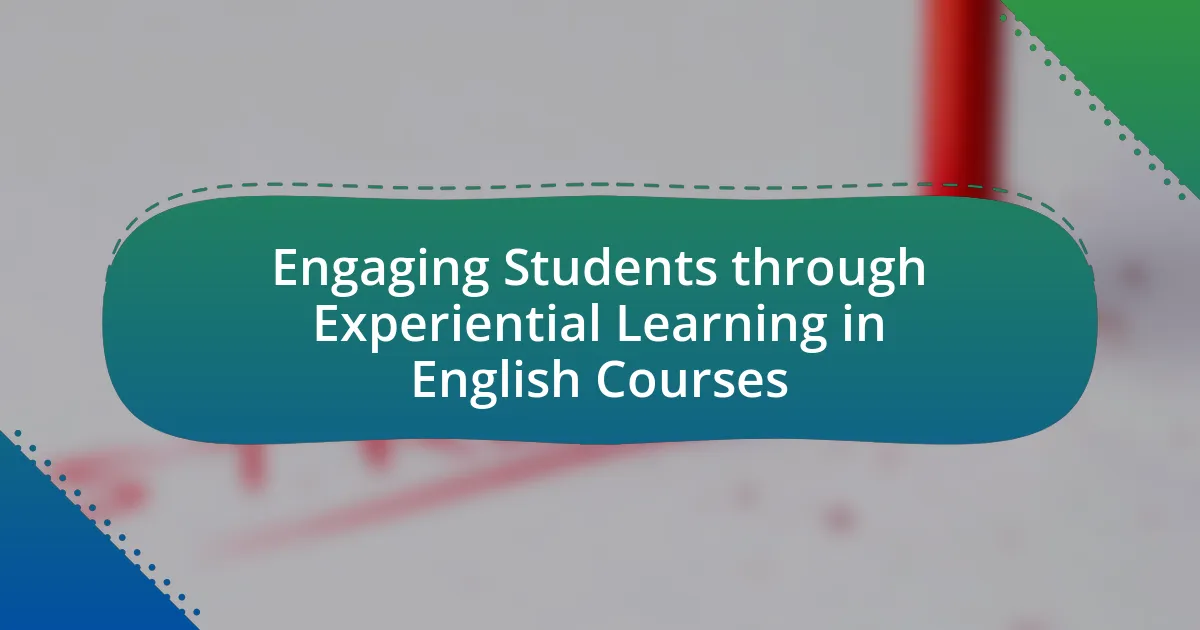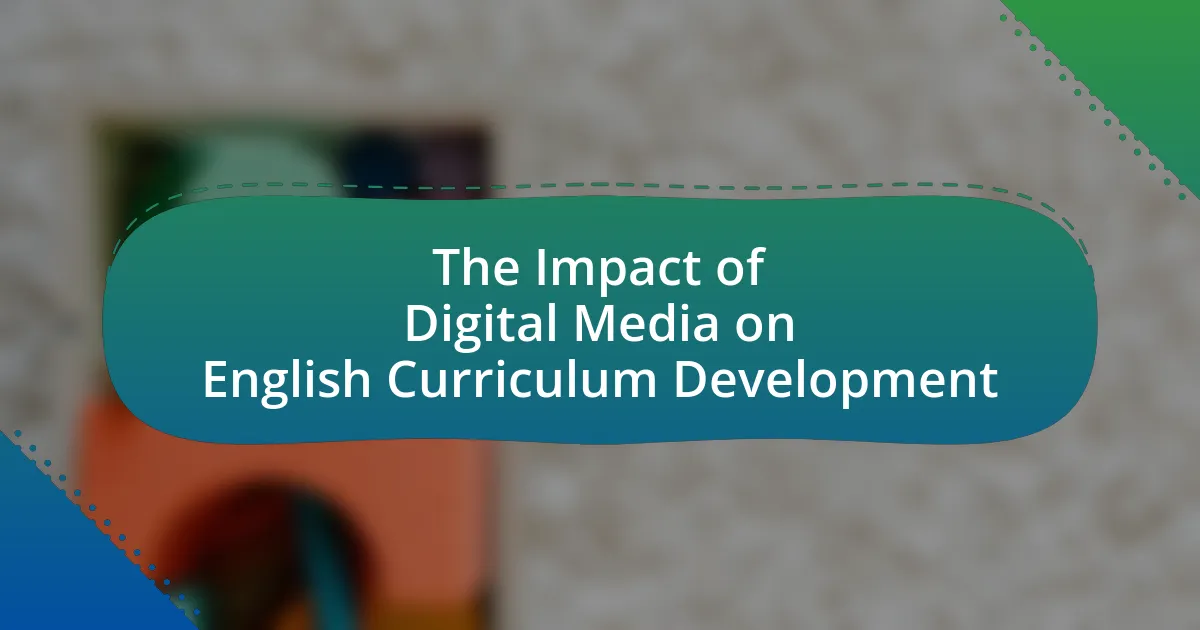Open Educational Resources (OER) in English Studies encompass a range of freely accessible and openly licensed materials, including textbooks, multimedia content, and assessment tools, designed to enhance teaching and learning in the discipline. This article evaluates the differences between OER and traditional educational resources, highlighting their benefits such as increased accessibility, cost savings, and support for diverse learning styles. It also addresses the challenges associated with OER implementation, including quality concerns and the need for faculty training, while emphasizing the importance of evaluating OER effectiveness to improve student engagement and learning outcomes. Additionally, the article explores emerging trends in OER, including the role of technology and collaborative platforms in resource creation and integration.
-in-English-Studies-1.webp)
What are Open Educational Resources (OER) in English Studies?
Open Educational Resources (OER) in English Studies are teaching, learning, and research materials that are freely accessible and openly licensed, allowing users to retain, reuse, revise, remix, and redistribute them. These resources include textbooks, course materials, multimedia content, and assessment tools specifically designed for English language and literature education. The use of OER in English Studies promotes equitable access to quality educational resources, enhances collaborative learning, and supports diverse teaching methodologies, as evidenced by studies showing that OER can improve student engagement and learning outcomes.
How do OER differ from traditional educational resources?
Open Educational Resources (OER) differ from traditional educational resources primarily in their accessibility and licensing. OER are freely available for anyone to use, modify, and distribute, often under licenses like Creative Commons, which promote sharing and collaboration. In contrast, traditional educational resources typically require purchase or subscription, limiting access and use. For example, a study by the Babson Survey Research Group in 2018 indicated that 78% of faculty members believe OER can reduce costs for students, highlighting the financial advantage of OER over traditional resources.
What types of OER are available for English Studies?
Various types of Open Educational Resources (OER) are available for English Studies, including textbooks, course materials, lecture notes, multimedia resources, and assessment tools. Textbooks such as “Writing Commons” provide comprehensive guides on writing and composition, while platforms like “OpenStax” offer free, peer-reviewed textbooks covering literature and language studies. Additionally, multimedia resources, including videos and podcasts, enhance learning experiences by providing diverse perspectives on literary analysis and critical theory. Assessment tools, such as quizzes and rubrics, support educators in evaluating student performance effectively. These resources are designed to be accessible and adaptable, promoting collaborative learning and teaching in English Studies.
How are OER created and maintained in the field of English Studies?
Open Educational Resources (OER) in the field of English Studies are created and maintained through collaborative efforts among educators, institutions, and organizations. These resources are typically developed by faculty members who design course materials, such as textbooks, lesson plans, and multimedia content, that are freely accessible and openly licensed. Maintenance involves regular updates and revisions based on user feedback, advancements in pedagogy, and changes in curriculum standards. For instance, initiatives like the Open Textbook Library provide a platform for educators to share and adapt OER, ensuring that materials remain relevant and effective for teaching English.
Why is the evaluation of OER important in English Studies?
The evaluation of Open Educational Resources (OER) is important in English Studies because it ensures the quality, relevance, and effectiveness of educational materials used in the discipline. By assessing OER, educators can identify resources that align with curriculum standards and pedagogical goals, thereby enhancing student learning outcomes. Research indicates that high-quality OER can improve engagement and accessibility in English Studies, as they often provide diverse perspectives and inclusive content. Furthermore, evaluating OER helps in maintaining academic integrity and fostering a culture of continuous improvement in teaching practices.
What criteria should be used to evaluate OER effectiveness?
To evaluate the effectiveness of Open Educational Resources (OER), criteria such as accessibility, adaptability, engagement, and learning outcomes should be used. Accessibility ensures that resources are available to all learners, including those with disabilities, which is supported by the Web Content Accessibility Guidelines (WCAG). Adaptability refers to the ability to modify resources to fit different educational contexts, enhancing relevance and usability. Engagement measures how well the resources capture and maintain learners’ interest, which can be assessed through user feedback and interaction metrics. Learning outcomes focus on the impact of OER on student performance and knowledge retention, often evaluated through assessments and comparative studies showing improved results in courses utilizing OER versus traditional materials.
How does the evaluation process impact teaching and learning outcomes?
The evaluation process significantly impacts teaching and learning outcomes by providing feedback that informs instructional practices and enhances student engagement. When educators assess student performance and learning processes, they can identify strengths and weaknesses, allowing for targeted interventions that improve educational effectiveness. Research indicates that formative assessments, which are integral to the evaluation process, lead to higher student achievement by fostering a growth mindset and encouraging active participation in learning. For instance, a study published in the “Journal of Educational Psychology” by Black and Wiliam (1998) found that formative assessment can raise student performance by an average of 0.7 standard deviations, demonstrating its effectiveness in enhancing learning outcomes.
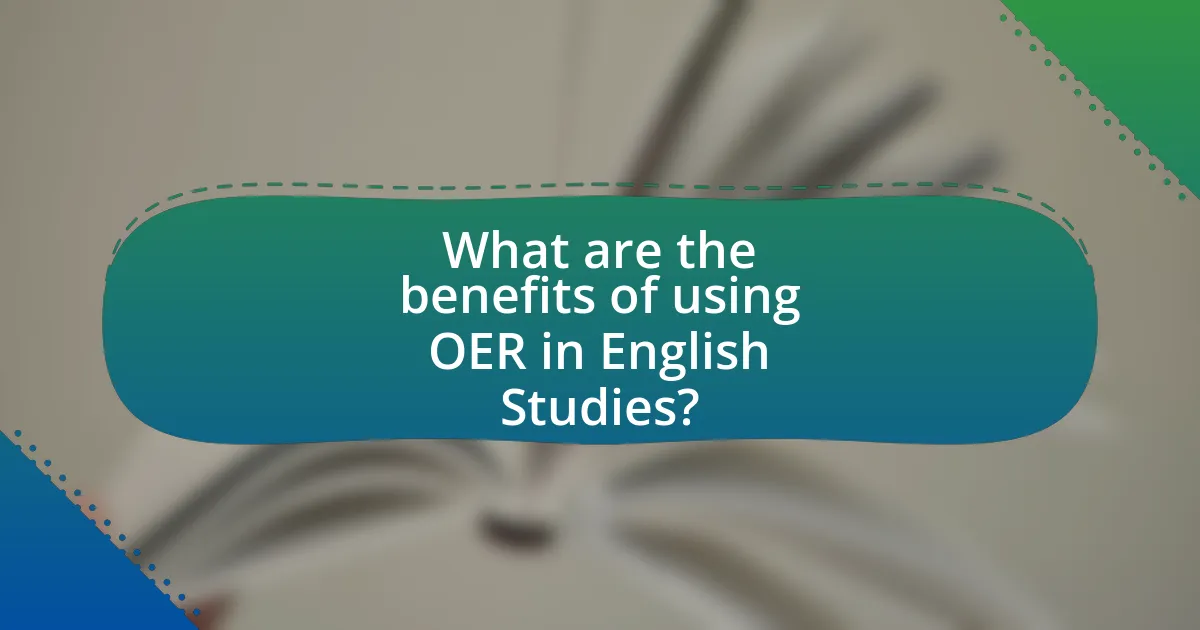
What are the benefits of using OER in English Studies?
The benefits of using Open Educational Resources (OER) in English Studies include increased accessibility, cost savings, and enhanced collaboration among educators. OER provides free and openly licensed materials that allow students from diverse backgrounds to access quality educational content without financial barriers. According to a study by the Babson Survey Research Group, 65% of students reported that the cost of textbooks affected their choice of courses, highlighting the financial relief OER can provide. Additionally, OER fosters collaboration among educators, enabling them to share and adapt resources, which can lead to improved teaching practices and curriculum development. This collaborative approach is supported by research from the Open Education Consortium, which emphasizes that OER encourages innovation and customization in educational materials.
How do OER enhance accessibility for students?
Open Educational Resources (OER) enhance accessibility for students by providing free and openly licensed educational materials that can be accessed anytime and anywhere. This unrestricted access allows students from diverse backgrounds, including those with financial constraints, to obtain high-quality learning resources without the burden of textbook costs. According to a study by the Babson Survey Research Group, 70% of students reported that OER helped them save money, which directly contributes to increased participation and retention in educational programs. Additionally, OER can be adapted and modified to meet the specific needs of different learners, further promoting inclusivity and personalized learning experiences.
What role does OER play in promoting equity in education?
Open Educational Resources (OER) play a crucial role in promoting equity in education by providing free and accessible learning materials to all students, regardless of their socioeconomic status. OER eliminates financial barriers associated with traditional educational resources, enabling a wider range of learners to access quality educational content. For instance, a study by the Babson Survey Research Group found that 70% of students reported that OER helped them save money on textbooks, which directly impacts their ability to participate fully in their education. Additionally, OER fosters inclusivity by allowing educators to adapt and modify resources to meet diverse learning needs, thereby supporting varied educational contexts and promoting a more equitable learning environment.
How can OER support diverse learning styles in English Studies?
Open Educational Resources (OER) can support diverse learning styles in English Studies by providing a variety of materials that cater to different preferences, such as visual, auditory, and kinesthetic learning. OER includes multimedia resources like videos, interactive simulations, and text-based materials, allowing students to engage with content in ways that suit their individual learning styles. Research indicates that using varied instructional materials can enhance student engagement and comprehension, as evidenced by a study published in the “International Review of Research in Open and Distributed Learning,” which found that students who accessed diverse resources performed better academically. This adaptability of OER makes it a valuable tool for addressing the unique needs of learners in English Studies.
What cost savings do OER provide for students and institutions?
Open Educational Resources (OER) provide significant cost savings for students and institutions by eliminating or reducing the need for expensive textbooks and course materials. A study by the University of Massachusetts Amherst found that students using OER saved an average of $100 to $200 per course, which can lead to substantial financial relief over multiple semesters. Additionally, institutions benefit from OER by lowering overall course material costs, which can enhance enrollment and retention rates, as students are more likely to enroll in courses with affordable resources. This dual impact of cost savings for both students and institutions underscores the value of OER in higher education.
How can institutions leverage OER to reduce textbook costs?
Institutions can leverage Open Educational Resources (OER) to reduce textbook costs by adopting freely accessible educational materials that replace traditional textbooks. By integrating OER into their curricula, institutions can eliminate the financial burden of purchasing expensive textbooks for students. Research indicates that institutions utilizing OER have reported significant cost savings; for instance, a study by the University of Massachusetts Amherst found that students saved an average of $200 per course when OER were used instead of traditional textbooks. This approach not only alleviates financial strain on students but also promotes equitable access to educational resources, enhancing overall learning outcomes.
What are the long-term financial benefits of adopting OER?
Adopting Open Educational Resources (OER) leads to significant long-term financial benefits, primarily through cost savings on educational materials. Institutions that implement OER can reduce textbook expenses for students, which can average around $1,200 annually per student, according to the Student Public Interest Research Groups. Additionally, OER can decrease institutional costs associated with purchasing and licensing traditional textbooks, allowing funds to be reallocated to other educational resources or initiatives. Furthermore, OER promotes increased enrollment and retention rates, as lower costs make education more accessible, ultimately enhancing institutional revenue over time.
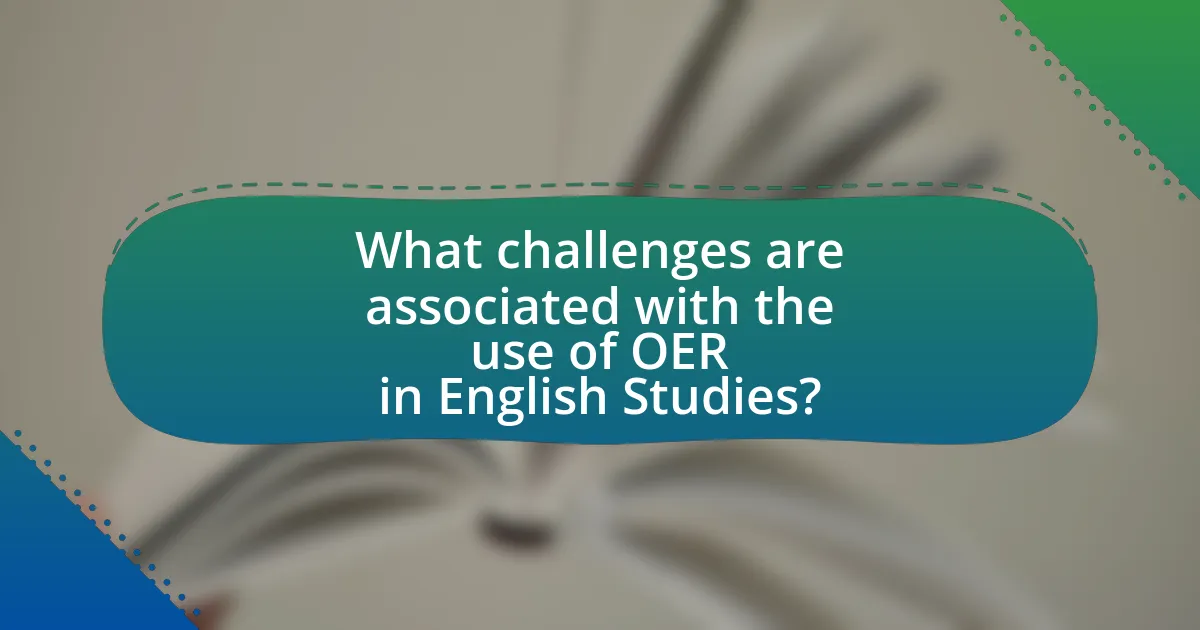
What challenges are associated with the use of OER in English Studies?
The challenges associated with the use of Open Educational Resources (OER) in English Studies include issues of quality, accessibility, and faculty training. Quality concerns arise because OER materials can vary significantly in academic rigor and relevance, potentially impacting student learning outcomes. Accessibility challenges often stem from the digital divide, where not all students have equal access to technology or the internet, hindering their ability to utilize OER effectively. Additionally, faculty may require training to effectively integrate OER into their curricula, as many educators are accustomed to traditional textbooks and may lack familiarity with OER platforms and resources. These challenges can impede the successful implementation of OER in English Studies.
What barriers do educators face when implementing OER?
Educators face several barriers when implementing Open Educational Resources (OER), including lack of awareness, insufficient training, and concerns about quality. Many educators are not familiar with OER, which limits their ability to integrate these resources into their teaching practices. Additionally, a study by the Babson Survey Research Group in 2016 found that 60% of faculty reported needing more training on how to effectively use OER. Concerns about the quality of OER also persist, as educators often question whether these resources meet academic standards, impacting their willingness to adopt them in the classroom.
How can institutions support faculty in overcoming these barriers?
Institutions can support faculty in overcoming barriers to the use of Open Educational Resources (OER) by providing targeted training and resources. For instance, offering workshops on OER integration can enhance faculty understanding and confidence in utilizing these materials effectively. Additionally, institutions can establish a dedicated support team to assist faculty in locating, adapting, and implementing OER, thereby reducing the time and effort required for these tasks. Research indicates that faculty who receive institutional support are more likely to adopt OER, as evidenced by a study published in the “International Review of Research in Open and Distributed Learning,” which found that 70% of faculty reported increased use of OER when provided with institutional resources and training.
What technological challenges are involved in using OER?
Technological challenges involved in using Open Educational Resources (OER) include issues related to accessibility, compatibility, and digital literacy. Accessibility challenges arise when OER materials are not designed to be usable by individuals with disabilities, which can limit their effectiveness in diverse learning environments. Compatibility issues occur when OER formats do not align with the technology or platforms used by educators and students, leading to difficulties in integration and use. Additionally, digital literacy is a significant challenge, as both educators and learners may lack the necessary skills to effectively navigate and utilize OER, which can hinder the overall adoption and impact of these resources in educational settings.
How can the quality of OER be ensured in English Studies?
The quality of Open Educational Resources (OER) in English Studies can be ensured through rigorous peer review processes, alignment with established educational standards, and continuous feedback from users. Implementing a peer review system allows experts in English Studies to evaluate the content for accuracy, relevance, and pedagogical effectiveness. Aligning OER with standards such as the Quality Matters rubric ensures that resources meet specific educational criteria, enhancing their reliability. Additionally, gathering and analyzing user feedback helps identify areas for improvement, ensuring that the resources remain effective and up-to-date. These methods collectively contribute to maintaining high-quality OER in English Studies.
What best practices should be followed for OER curation?
Best practices for OER curation include assessing the quality of resources, ensuring alignment with educational goals, and maintaining proper licensing. Quality assessment involves evaluating the accuracy, relevance, and pedagogical effectiveness of the materials. Alignment with educational goals ensures that the curated resources meet the specific learning outcomes desired in English studies. Proper licensing is crucial to confirm that resources are legally shareable and modifiable, which is a fundamental principle of Open Educational Resources. These practices enhance the effectiveness and accessibility of OER in educational settings.
How can peer review processes enhance OER quality?
Peer review processes enhance Open Educational Resources (OER) quality by ensuring that materials undergo rigorous evaluation by experts in the field. This evaluation helps identify inaccuracies, improve content clarity, and ensure alignment with educational standards. Research indicates that peer-reviewed resources are more likely to be accurate and pedagogically sound, as they benefit from diverse perspectives and expertise. For instance, a study published in the “International Review of Research in Open and Distributed Learning” found that peer-reviewed OER significantly improved learner outcomes compared to non-reviewed materials, highlighting the importance of quality assurance in educational resources.
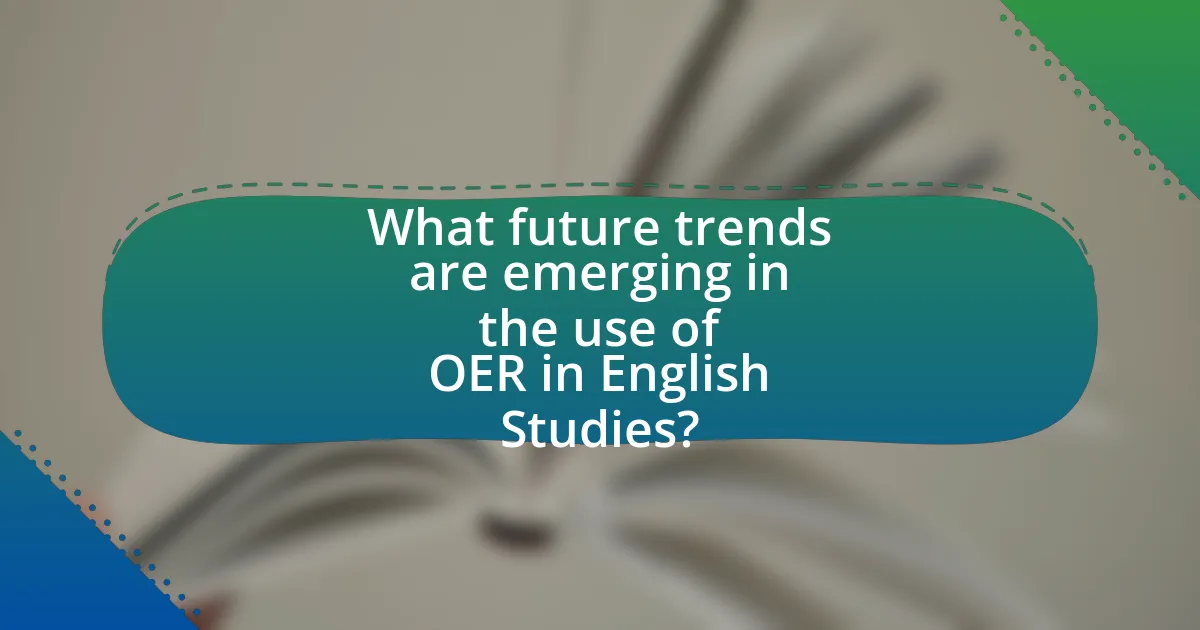
What future trends are emerging in the use of OER in English Studies?
Emerging trends in the use of Open Educational Resources (OER) in English Studies include increased collaboration among educators, the integration of technology-enhanced learning tools, and a focus on accessibility and inclusivity. Educators are increasingly collaborating to create and share OER, fostering a community-driven approach that enhances resource quality and relevance. Additionally, the integration of digital platforms and multimedia resources is becoming more prevalent, allowing for interactive and engaging learning experiences. Furthermore, there is a growing emphasis on ensuring that OER are accessible to diverse learners, aligning with universal design principles to accommodate various learning needs. These trends reflect a shift towards more collaborative, technologically advanced, and inclusive educational practices in English Studies.
How is technology shaping the development of OER?
Technology is significantly shaping the development of Open Educational Resources (OER) by facilitating the creation, distribution, and accessibility of educational materials. Digital platforms enable educators to collaboratively develop and share resources, while tools like Learning Management Systems (LMS) and content repositories streamline access for learners. For instance, the rise of cloud computing allows for the storage and sharing of large educational files, making it easier for institutions to adopt OER. Additionally, advancements in multimedia technology enhance the interactivity and engagement of OER, catering to diverse learning styles. According to a report by the William and Flora Hewlett Foundation, the use of technology in OER has led to increased adoption rates in educational institutions, demonstrating its impact on teaching and learning practices.
What role do collaborative platforms play in OER creation?
Collaborative platforms play a crucial role in the creation of Open Educational Resources (OER) by facilitating collective input and resource sharing among educators and learners. These platforms enable users to collaboratively develop, edit, and disseminate educational materials, which enhances the diversity and quality of resources available. For instance, platforms like WikiEducator and OER Commons allow multiple contributors to work together, ensuring that resources are continuously updated and improved based on user feedback and expertise. This collaborative approach not only democratizes content creation but also fosters a sense of community among educators, ultimately leading to more effective and relevant educational materials in English studies.
How might artificial intelligence influence OER in English Studies?
Artificial intelligence may significantly enhance Open Educational Resources (OER) in English Studies by personalizing learning experiences and improving resource accessibility. AI algorithms can analyze student performance data to tailor educational materials to individual learning styles, thereby increasing engagement and comprehension. For instance, platforms like Coursera and edX utilize AI to recommend courses based on user behavior, demonstrating the effectiveness of personalized learning pathways. Additionally, AI can facilitate the creation of adaptive learning technologies that adjust content in real-time, ensuring that students receive the most relevant resources. This capability is supported by research indicating that personalized learning can lead to improved academic outcomes, as evidenced by a study published in the “Journal of Educational Psychology,” which found that tailored educational interventions can enhance student achievement.
What practical steps can educators take to effectively integrate OER into their curriculum?
Educators can effectively integrate Open Educational Resources (OER) into their curriculum by first identifying relevant OER materials that align with their learning objectives. This involves conducting thorough searches on platforms like OER Commons or MERLOT to find high-quality resources that meet specific educational needs.
Next, educators should adapt and customize these resources to fit their teaching context, ensuring that they are culturally relevant and accessible to all students. This customization can include modifying content, adding local examples, or incorporating diverse perspectives to enhance engagement.
Additionally, educators can collaborate with colleagues to share OER findings and best practices, fostering a community of practice that encourages the exchange of ideas and resources. Professional development workshops focused on OER can also equip educators with the skills needed to effectively implement these resources in their teaching.
Finally, assessing the impact of OER on student learning outcomes is crucial. Educators should gather feedback from students and analyze performance data to evaluate the effectiveness of the integrated OER, making adjustments as necessary to improve the learning experience.
How can educators assess the suitability of OER for their courses?
Educators can assess the suitability of Open Educational Resources (OER) for their courses by evaluating the alignment of the OER content with their curriculum objectives and learning outcomes. This involves reviewing the quality, relevance, and accessibility of the materials, ensuring they meet the academic standards required for the course. For instance, educators can utilize established evaluation frameworks such as the Achieve OER Rubric, which provides criteria for assessing the alignment of OER with educational goals, including clarity, accuracy, and engagement. Additionally, feedback from students and peer reviews can serve as valuable indicators of the effectiveness and appropriateness of the OER in enhancing learning experiences.
What strategies can be employed to encourage student engagement with OER?
To encourage student engagement with Open Educational Resources (OER), institutions can implement strategies such as integrating OER into the curriculum, providing training for faculty on OER utilization, and fostering a collaborative learning environment. Integrating OER into the curriculum ensures that students have access to relevant and diverse materials that enhance their learning experience. Training faculty on how to effectively use and promote OER can lead to more engaging teaching practices, as evidenced by studies showing that faculty who are well-versed in OER are more likely to incorporate them into their courses. Additionally, creating a collaborative learning environment, where students can share and discuss OER, promotes active participation and deeper understanding, supported by research indicating that peer interaction enhances engagement and retention in educational settings.



